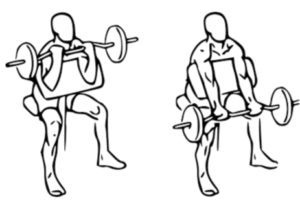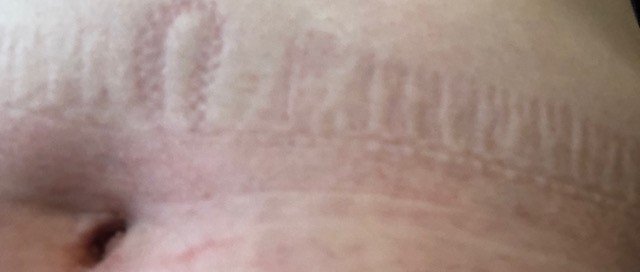Which Burns More Fat? Running Level Courses or Walking Hills?

The question of “Which burns more fat, walking hills or running on level land?” is too broad a question to say one or the other burns more fat. (more…)
Exercise Guidelines for TIA Patients: Transient Ischemic Attack

The idea of starting an exercise program after suffering from a transient ischemic attack can be daunting to some patients.
People who’ve had a TIA will often wonder if it’s safe to exercise.
A TIA (transient ischemic attack) is a mini stroke, or, to put it another way, a temporary stroke, caused by a blood clot that chokes off blood supply to part of the brain.
TIA symptoms (weakness or numbness or heaviness on one side of body, unsteady gait, loss of balance, vision disturbances, severe headache, slurred speech, confusion) will last a few minutes to up to 24 hours, then spontaneously resolve.
However, the disappearance of TIA or transient ischemic attack symptoms does not mean all is well.
Since high blood pressure is a major risk factor for stroke, and exercise increases blood pressure, you absolutely must delay your next workout session until you have had clearance from a cardiologist to resume (or begin) exercise.
“Exercising in individuals who may have had a TIA is dangerous,” says Teresa Caulin-Glaser, MD, a cardiologist and senior vice president with Service Lines, OhioHealth.
“It is important for individuals to understand that TIAs associated with even brief periods of ischemia (symptoms) can cause permanent brain injury.
“If you have had symptoms of a TIA, you are at increased risk of a stroke.
“Anyone with a new symptom that may be suggestive of a TIA needs urgent evaluation and treatment, since immediate intervention may substantially reduce the risk of a significant debilitating stroke.”
If you had a TIA but don’t get treatment, and then exercise or physically exert yourself (heavy yard work, roughhousing with grandkids, taking out garbage, etc.), the blood pressure increase from the physical activity can outright cause a stroke — not necessarily another TIA, but a full-blown stroke.
But does this mean that exercise is permanently off-limits to a person who had a transient ischemic attack?
“Exercise at a moderate level of intensity is beneficial to individuals who have had a TIA once the patient has been treated and cleared by their physician to begin an exercise program,” says Dr. Caulin-Glaser.

Source: cancer.gov
“It is important to remember, if a patient has cerebral vascular disease they are at higher risk for also having coronary artery disease, and therefore beginning an exercise program should be initiated only after physician assessment and approval.”
What about people, who were already regularly exercising, prior to the TIA?
Dr. Caulin-Glaser explains, “The individuals still have newly diagnosed vascular disease, and as such should have a stress test with an exercise prescription stating the appropriate heart rate ranges for exercise.
“The stress test will confirm their blood pressure and heart rate responses to maximal exercise are appropriate on the new medications.”
Must people with a TIA history permanently par back on exercise intensity, even if their blood pressure is under control?
Dr. Caulin-Glaser says, “It may not be necessary to par back; the stress test will help make the determination on what is the appropriate level of exercise for each individual.
“Increasing awareness and education regarding the safe approach to a great exercise program is not a limitation, but an endorsement for them to continue lifelong exercise.”

Dr. Caulin-Glaser is an experienced physician, teacher and researcher in the specialty of cardiovascular disease, and formerly the system vice president for Heart & Vascular Services at OhioHealth.
 Lorra Garrick has been covering medical, fitness and cybersecurity topics for many years, having written thousands of articles for print magazines and websites, including as a ghostwriter. She’s also a former ACE-certified personal trainer.
Lorra Garrick has been covering medical, fitness and cybersecurity topics for many years, having written thousands of articles for print magazines and websites, including as a ghostwriter. She’s also a former ACE-certified personal trainer.
.
Top image: ©Lorra Garrick
Is 60 Minutes of Cardio Exercise Too Much at Once?

First of all, it depends on if the one hour of cardio exercise is done three times per week versus every day.
So let’s just start with several times a week.
One hour of cardio is not too much if it’s done on non-weight-lifting days, and especially if it includes a warm-up and warm-down.
However, physique and bodybuilding competitors, beginning about two weeks before a contest, will do an hour (or more) of moderate cardio the same day they lift weights, though usually, the aerobics will be done apart from the weights.
Some fitness professionals believe that an hour of HIIT cardio is way too much, even if done only twice a week, because after 40 minutes of HIIT, fat-burning hormones (produced by HIIT) cease to oppose the stress hormone that HIIT also produces.
Buildup of this stress hormone will then interfere with fat loss efforts.
Personally, I have never had this problem when doing HIIT for longer than 40 minutes; I’ve done it for a sixty minutes outdoors in the hills and never saw an impediment to my body fat percentage.
Aerobics done at a casual pace for sixty minutes, following weightlifting, is not too much.
But when people ask, “Is one hour of cardio too much?” I take this to mean an actual cardiorespiratory workout, rather than just mere time spent strolling around a track like an automaton or pedaling like a zombie on the bike and not even sweating.
Bottom line: In and of itself, an hour of aerobic exercise is not too much, as an isolated workout.
Your ancient ancestors did sixty minutes or more of sustained cardio many days of the week.
Sixty minutes of cardio on a daily basis is a different ball game. This isn’t excessive if this is all a person does, or if their weight lifting is mild and especially if it’s of short duration, versus moderate or intense weight lifting.
An hour of cardio every day may also be in order for certain kinds of competitive athletes, and people who, due to injury, must substantially curtail their strength training.
An hour of cardio is not too much for someone who spends most of the day in a chair and hardly lifts weights.
 Lorra Garrick has been covering medical, fitness and cybersecurity topics for many years, having written thousands of articles for print magazines and websites, including as a ghostwriter. She’s also a former ACE-certified personal trainer.
Lorra Garrick has been covering medical, fitness and cybersecurity topics for many years, having written thousands of articles for print magazines and websites, including as a ghostwriter. She’s also a former ACE-certified personal trainer.
.
Top image: Shutterstock/Brocreative
Treadmill vs. Track for Running & Walking: Pros and Cons

If you compare the treadmill to track running or walking at the same speeds, then yes, there is some compromise.
In other words, 7 mph on a treadmill is a bit easier than 7 mph on an outdoor track.
So even though a duplicate speed comparision might make the treadmill seem easier than a track, the real issue is whether or not you can get a treadmill to bring you to pure cardio exhaustion. The answer to that is YES.
Though the tread moves beneath your feet, your feet must keep up with it, and this requires plenty of work at fast enough speeds or with a high enough incline.
How long can you walk on the machine at 4 mph at 15 percent incline? Try it. And do not hold on, either!
How long can you run on the machine at 8 mph at 15 percent incline? Try it, and keep your hands off the equipment!
Running outdoors or on a track, of course, will better prepare you for actually having to run somewhere from point A to point B, than will the best treadmill workout, because no matter how rigorous you make a treadmill session, you can also make a track session very strenuous as well.

Shutterstock/Phase4Studios
The closer the training session mode is to what you want to train for, the more effective that mode is.
So if you want to become more efficient on a basketball court, or at sprinting across a parking lot in the rain, then track running will increase your efficacy more than treadmill running will, especially since on a track, you can change direction.
A treadmill provides a linear workout, and this is one of its limitations. Another limitation of the machine is that the surface is smooth and not variable.
A track may also be smooth and nonvariable, but then again, there are gravel tracks, and outdoor running/walking can also include grassy and rocky surfaces.
An advantage to a treadmill is that you can monitor your speed. Working out on a track or outdoors means you may begin slowing down and not realize it.
A machine also provides a fixed program of speeds and inclines, that force you to adjust your effort level; it’s easier to become lax while running on some lazy country road.
Something to consider: If you’re outside walking or running and you feel like quitting, you can’t just quit; you have to complete the workout by returning to your car or house, even though if you’re at the local school track, your car may be only 100 yards away.
But indoors on a machine makes it easier to quit your routine prematurely.
Strenuous treadmill workouts will definitely carry over to outdoor running as well as the running required for athletic activities, especially if the treadmill sessions include high intensity interval training – but again, literally running from point A to point B is the preferred training regimen.
The point is: Don’t underestimate what a machine can do for you, but at the same time, it’s always wise to include track or outdoor cardio sessions in your exercise program.
 Lorra Garrick is a former personal trainer certified through the American Council on Exercise. At Bally Total Fitness she trained women and men of all ages for fat loss, muscle building, fitness and improved health.
Lorra Garrick is a former personal trainer certified through the American Council on Exercise. At Bally Total Fitness she trained women and men of all ages for fat loss, muscle building, fitness and improved health.
.
Top image: Shutterstock/wavebreakmedia
Stopped Losing Weight Despite Doing HIIT ?

Have your HIIT workouts lost steam at causing weight loss, and now you’re stuck in the mud in a plateau, unable to budge off more fat?
So here you are, watching those pounds drop, and then suddenly … the weight loss stops. What happened?
Is weight loss supposed to stop at some point while sticking to a HIIT program?
If your weight loss has stopped, despite you sticking faithfully to HIIT two or three times a week, you must evaluate other things you’re doing that have interrupted your weight loss efforts.
When a person who wishes to shed pounds starts a HIIT program, the weight will start coming off, and often, quite noticeably.
Introduction of HIIT to a person’s lifestyle creates a metabolic jolt, and the result is more fat-burning than ever before.
This will happen, even if the person has poor eating habits, because high intensity interval training creates such a shock to the body, that the body responds by burning up fat at an unprecedented rate.
However, poor eating habits may get in the way of this eventually. You’re either overeating, or … under-eating.
If you’re overeating, simply shrink the portions or cut down or out the junk food.

Freepik.com,/schantalao
If you’re under-eating, this calorie restriction has lost its ability to sustain your hardcore interval workouts.
Initially, the reduced food intake was able to support your new HIIT program.
But there comes a point where the body just says, “Gee, I need more fuel to keep this up. I can’t let any more fat get melted away. I must hold onto fat reserves for energy.”
The result is that your weight loss has stopped, even though the HIIT goes on.
- Are you letting long periods of time go by between eating? This can slow metabolism and interfere with weight loss plans.
- Is your daily calorie intake too low for all of your physical activity? If it is, the body will fight back by putting a halt on weight loss, to conserve stored body fat for fuel that the body is not getting from food.
Increase your food intake by 5-10 percent and see if this doesn’t jumpstart weight loss, but continue doing HIIT. Never go more than three hours between eating.
If under- or overeating don’t apply to you, or if changing your eating habits doesn’t solve the problem, then re-evaluate your high intensity interval training program.
Is it always on the same cardio equipment? If so, switch up the equipment. If it’s done outside, replace some outside workouts with cardio equipment.

Shutterstock/Maksym Poriechkin
Perhaps your body has adapted to using the same cardio mode over and over for high intensity interval training.
Also see if lately you’ve been slacking on your strength training. Maybe you’ve been going light on the strength training, figuring that the HIIT will take care of all the weight loss.
Beef up other areas of your training. Finally, maybe you’re not pushing as hard as you used to with your intensity intervals. Are you truly going at it with full power, full speed, full throttle?
Make any number of these adjustments if your weight loss has stopped amid consistent HIIT workouts, and your progress should resume.
 Lorra Garrick is a former personal trainer certified through the American Council on Exercise. At Bally Total Fitness she trained women and men of all ages for fat loss, muscle building, fitness and improved health.
Lorra Garrick is a former personal trainer certified through the American Council on Exercise. At Bally Total Fitness she trained women and men of all ages for fat loss, muscle building, fitness and improved health.
.
Top image: Freepik.com/katemangostar
Can Platelet-Rich Plasma Treat Tendonitis & Torn Tendons ?

“Most tendon related pain is due to degeneration,” says Nathan Wei, MD, board-certified rheumatologist specializing in regenerative medicine like platelet rich plasma injections to treat conditions including tendonitis. (more…)
When a Personal Training Client Wants a Weight Loss Guarantee

“So can you guarantee that I’ll lose weight?”
You were probably caught off guard, and searched for the right words, while this new client watched you struggle.
You just told your new or about-to-be client that you will help her (or him) lose weight, perhaps even specifying how much weight.
Next thing you know, the client is pinning you down for a weight loss guarantee.
Somewhere in that contract is language relating to results not guaranteed. It’s there; you must hunt for it.
When you find it, remember where it’s located; then, when a prospective or new client asks if you can guarantee weight loss, show him or her the language.
You can add to it by saying, “Club policy is that results, including weight loss, are not guaranteed, because results are very dependent upon how hard and consistently the client is willing to work; plus, personal trainers rely on an honor system, in that we assume that clients are being truthful and accurate when reporting their eating habits and whether or not they’ve been sticking to exercise outside of the personal training sessions.”
If this response sounds too strong or even harsh, remember that HOW you say it will make a difference.
Use the correct voice, tone and inflection, and the client will respect you and see you as a confident professional.
I never had any negative reactions when I responded to the weight loss guarantee question.
Another way to respond: “Weight loss is never guaranteed because there are too many variables that can affect weight loss progress.”
Follow that up with, “What I DO guarantee is that you will get top-notch personal training and nutrition advice, that will, in combination with your participation, be the best you can do for reaching your weight loss goals.”
If a client is still not satisfied, it’s time to get the club’s fitness director involved.
If you’re a private personal trainer, then realize you may have a “difficult” client on your hands who, perhaps, is anticipating that she or he won’t be sticking to your weight loss program very faithfully.
 Lorra Garrick has been covering medical, fitness and cybersecurity topics for many years, having written thousands of articles for print magazines and websites, including as a ghostwriter. She’s also a former ACE-certified personal trainer.
Lorra Garrick has been covering medical, fitness and cybersecurity topics for many years, having written thousands of articles for print magazines and websites, including as a ghostwriter. She’s also a former ACE-certified personal trainer.
.
Top image: Shutterstock, Jacob Lund
Symptoms of Low Blood Pressure, Dangers & Solutions

You hear a lot about the dangers of HIGH blood pressure, but guess what: LOW blood pressure can kill you.
Do you know the symptoms of low blood pressure and how to safely raise it?
Blood pressure that is too low can be serious or harmless or something in between.
Low blood pressure (hypotension) has many causes including heart conditions, nutritional deficiencies and medications.
The cut-off for normal BP readings and high readings is 140 over 90. So when does blood pressure get too low?
“The first question to address is if the blood pressure is really too low,” says Teresa Caulin-Glaser, MD, a cardiologist and senior vice president with Service Lines, OhioHealth..
“In general, if patients are asymptomatic and the systolic (“top number”) blood pressure is approximately 90mmHg or better, you do not need to treat.
“However, if the person is developing symptoms such as dizziness, fatigue, and/or passing out, there needs to be a full history and medical evaluation.”
If you believe your blood pressure is too low, review any medications you’ve been taking.
Explains Dr. Caulin-Glaser: “If the evaluation determines there are no medical problems and/or medications such as diuretics, ace-inhibitors, beta blockers, calcium channel blockers causing low blood pressure and symptoms, then there are non-pharmacologic treatments that can be implemented.”
Other Symptoms of Low Blood Pressure
Lack of concentration, blurred vision, fatigue, nausea, thirst, cold and clammy skin, and rapid shallow breathing.
A big danger of low blood pressure is organ damage due to insufficient blood supply to them.
As you can see, low blood pressure can present with an assortment of symptoms, while high BP (also known as hypertension), which is a major risk factor for stroke, offers up no symptoms, which is why hypertension is nicknamed “the silent killer.”
How do you raise low blood pressure that’s creating symptoms?
Dr. Caulin-Glaser says, “Some simple options for treatment are drinking fluids to decrease the risk of dehydration, increasing the amount of sodium in the diet, and decreasing alcohol intake.
“There are medications such as fludrocortisone that can be considered in the treatment of symptomatic low blood pressure, but this would be under the direction of a physician after a full medical evaluation.”
Other Causes of Low Blood Pressure
Vitamin B12 deficiency causing anemia (result of a vegan diet, since this vitamin is found in animal-derived foods); pregnancy; low blood sugar; severe infection.
The low blood pressure that’s caused by infections of the urinary tract, lungs or abdomen, can be fatal.
Typically whenever one sees a doctor for any reason, a BP reading is taken.
It’s perfectly okay to request that your blood pressure be taken at the conclusion of the doctor visit, because by then, much of your anxiety will be diminished.
Otherwise, your readings may be uncharacteristically high if taken at the beginning of the visit, due to anxiety; this is known as white-coat syndrome.
Low blood pressure has many causes, but if there are no accompanying symptoms, then you need not worry about having BP that is below normal.

Dr. Caulin-Glaser is an experienced physician, teacher and researcher in the specialty of cardiovascular disease, and formerly the system vice president for Heart & Vascular Services at OhioHealth.
 Lorra Garrick has been covering medical, fitness and cybersecurity topics for many years, having written thousands of articles for print magazines and websites, including as a ghostwriter. She’s also a former ACE-certified personal trainer.
Lorra Garrick has been covering medical, fitness and cybersecurity topics for many years, having written thousands of articles for print magazines and websites, including as a ghostwriter. She’s also a former ACE-certified personal trainer.
.
Top image: Shutterstock/TeodorLazarev
Safety Guidelines for Seniors and Strength Training Equipment

Bad form stunts results, wastes time, and can cause injury or strain to joints and muscles, especially in senior age people who are new to strength training machines.
Senior Strength Training Safety Guidelines
Seated cable row
This is where you’re upright and seated, feet against foot pad. Your hands are in front and holding a handle attacked to a weight stack.
You pull this handle towards your chest, then release the handle back to its starting point, using control, to work the back and arms.
Seniors need to employ upright spinal position while pulling the handle towards their chest.
Do not lean back as you pull towards yourself; this is cheating and de -isolates the targeted muscles. If you can’t help but lean back, this means the load is too heavy for you.
Seated selectorized row
Here you are also in an upright position, chest against a support pad.
Reach beyond this pad to grab the machine’s handles and pull towards your chest.
Keep your chest against the pad; do not disconnect it. If you can’t keep it to the pad, the load needs to be lighter.
Lat pull-down
You are seated and pull a bar, that’s over your head in the start position, down to face or neck level. This too targets your back and arms.
- Grip can be overhand or underhand, or neutral (palms facing each other, depending on handle used)
- Grip can be wide, medium or narrow.

Freepik.com
Keep your forearms vertical. Do not bend the forearms parallel to the floor. This is wrong. If you’re able to do this, the load is TOO LIGHT.
Next, do not yank the bar down. Do not let your back get crooked. Pull the bar down with control rather than sloppily or with yanking. You risk injury otherwise. If you must yank, the load is too heavy.
Preacher/seated curl
With this strength training exercise, one sits against a support at chest level.
Palms up, place arms over this support pad and take hold of the handles at the pad’s bottom. Pull these handles towards your face to work the biceps.

Everkinetic.com
I’ve seen many senior age men lift their behinds off the seat as they struggled to bring the handles all the way up.
This is cheating. It’s so wrong. This cheat move tricks seniors into thinking they’re far stronger than they actually are.
Keep your bottom on the seat and let your biceps do all the work, so you can see how much your biceps can actually handle.
Release (uncurl) the resistance to just a tiny bit above the start point, to work the entire range of motion.
Some seniors bring it down only half way and then curl up again. This is an incomplete repetition that recruits only half the intended muscle.
If you can’t bring the weight up after lowering it down full range of motion, the resistance is too heavy and needs to be reduced.
Practice all strength training moves with very light weight to perfect your form.
Some seniors want to be seen using a lot of weight during strength training, but this comes with a cost: cheating and risking injury.
When you cheat, you ultimately do not get nearly as strong as you would if you adhered to correct form.
You do not want a false sense of strength using these machines.
 Lorra Garrick is a former personal trainer certified through the American Council on Exercise. At Bally Total Fitness she trained women and men of all ages for fat loss, muscle building, fitness and improved health.
Lorra Garrick is a former personal trainer certified through the American Council on Exercise. At Bally Total Fitness she trained women and men of all ages for fat loss, muscle building, fitness and improved health.
.
Top image: Shutterstock, pikselstock
Do Skin Indents from Underwear or Pants Mean a Heart Problem?

It can be alarming to notice that your underwear leaves pronounced indentations in the skin about your waistline.
Congestive heart failure often causes edema.
Even not-so-tight panties can cause this, and the more patterned the underpants, the more intricate the indentations in your skin!
Does this mean edema from congestive heart failure?
After all, people with heart failure (failure of the heart muscle to pump blood in an efficient manner) often develop edema.
When people have pathological edema, you can press your fingertip into their skin for a few seconds, release it, and see an impression – that just lingers.
This is called pitting edema, and it can linger for several minutes.
This is not normal, though not everyone with pitting edema has a heart condition either.
Can heart failure cause one’s underpants to create indents in their skin?

“In rare circumstances,” says Jenepher Piper, a family practice nurse practitioner for Maryland Family Care for 25+ years and a former nurse with Home Care Nurse for Johns Hopkins Home Care.
Piper adds, “Edema would have to be profound to extend this high.”
If you have profound edema that’s extending to the height of your waist, believe me, you will probably already have been diagnosed with congestive heart failure or some other serious problem like kidney failure.
Furthermore, people who develop edema in their waist area from congestive heart failure or kidney problems will also have very visible edema in their legs.
Edema in the waist or abdominal region is not to be equated with excess fat (love handles, muffin top).
Anasarca
Anasarca is a type of edema or swelling that involves the entire body.
A heart problem and diabetes can cause this, but by the time it does, you will know that you’re as sick as a dog.
Underwear that leaves impressions in your skin does not mean you have anasarca, heart failure, diabetes or some other malady.
Wear looser underwear, but if it doesn’t require tight panties to cause skin indents, you still should NOT worry!
Piper explains that the human body is 50 to 60 percent water in an average size adult, and this percentage is higher in overweight people.
The elastic band of underwear will “displace water in the tissue, like a handprint in a memory foam mattress,” says Piper.
The indents will eventually work their way out.
 Patients suffering from conditions such as coronary artery disease, obesity and diabetes turn to Nurse Practitioner Piper to help them best manage their overall health.
Patients suffering from conditions such as coronary artery disease, obesity and diabetes turn to Nurse Practitioner Piper to help them best manage their overall health.
 Lorra Garrick has been covering medical, fitness and cybersecurity topics for many years, having written thousands of articles for print magazines and websites, including as a ghostwriter. She’s also a former ACE-certified personal trainer.
Lorra Garrick has been covering medical, fitness and cybersecurity topics for many years, having written thousands of articles for print magazines and websites, including as a ghostwriter. She’s also a former ACE-certified personal trainer.
.





























































